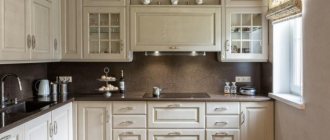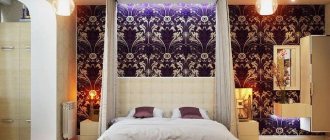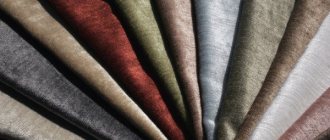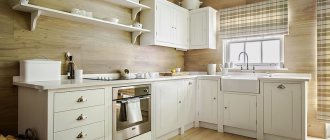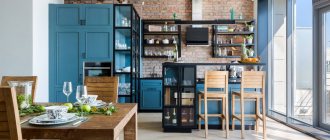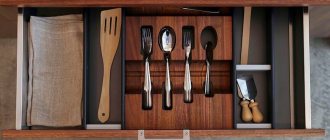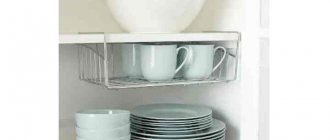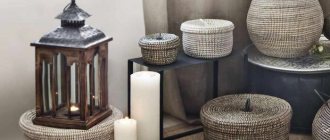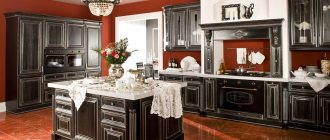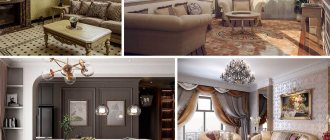Hi all! We quite often talk about modern interiors, but we forget about timeless classics. Therefore, today we will talk about pilasters in the kitchen, their application features, decorative possibilities and more.
I can safely say that pilasters are a very original solution that is not suitable for every room. Only those with sufficiently spacious premises can use them in the kitchen. It makes no sense to install them in a small Khrushchev-era building.
Pilasters do not provide much practical benefit. This is a full-fledged decor that can incredibly complement and decorate a kitchen in a classical style, baroque style and more.
Although Ancient Greece is considered its homeland, in fact, pilasters appeared in their final form in Ancient Rome. This is modern Italy.
Kitchen pilasters.
Kitchen pilasters or they can also be called furniture pilasters are used to decorate kitchen modules.
Pilasters make the overall appearance of the kitchen set more attractive and expressive. Typically, pilasters can be found in a kitchen designed in a classical style, such as Baroque or Victorian. But furniture pilasters can be used not only as kitchen facade decor. In addition to the fact that a pilaster is a decorative element of a kitchen set, it is also an opportunity to fill small spaces that remain after drawing up the overall composition with kitchen modules of standard sizes. Pilasters with a width of 150 mm can be used as facades for retractable bottle holders. Also, kitchen pilasters, symmetrically installed on both sides of the oven, will protect adjacent furniture facades from high temperatures.
Literally, pilaster is translated as column, pillar. A furniture pilaster is a vertical protrusion in the form of a facade decorative semi-column of a rectangular, semicircular or complex shape. A kitchen pilaster can consist of three parts: a base, a trunk and a capital - the upper decorative part, although it can also be made in a simpler form. The back part of the kitchen pilaster, with which it is attached to the elements of cabinet furniture, is flat, and the front, visible part of the pilaster can be figured, decorated with various three-dimensional, carved patterns. Also often found are kitchen pilasters, the main part of which is the trunk, decorated with vertical grooves, alternating recesses and elevations, and ribs.
Kitchen furniture pilaster is made of solid wood or MDF board, lined with veneer, film or coated with enamel. Typically, the color of the furniture pilaster matches the color of the facades of the kitchen unit, while the shaped volume is often emphasized with the help of patination.
furniture pilasters in the kitchen
Thanks to decorative overlays - furniture pilasters, the kitchen set looks expensive, rich and respectable.
How to choose a kitchen from an array?
Solid wood kitchens are usually not made from one hundred percent wood. The base is made from laminated chipboard (laminated chipboard), MDF, plywood. The facades are also not always made one hundred percent of wood. The doors in this case are made either of solid panels or of a wooden frame with an insert. The central part of the frame (panel) is veneered MDF, chipboard or glass.
Kitchen facades from solid wood are actually not made: it is labor-intensive, expensive, and there are difficulties in operating such furniture. Manufacturers use eurobeams - spliced wood segments. This not only makes the furniture cheaper, but also increases its wear resistance.
Pilasters and their differences from columns
A pilaster is a vertical projection of a wall, usually having a base and a capital, and thereby conventionally representing a column.
In this way, a pilaster differs from a blade - a vertical flat protrusion of a wall that does not have a base or capital. Pilasters are one of the architectural elements proposed by the architects of Ancient Greece and actively used to this day. The period of oblivion for pilasters covered the entire Middle Ages; Like other classical architectural elements, pilasters became popular again beginning with the early Italian Renaissance.
Pilasters owe their return to architecture to Leon Battista Alberti, one of the main theorists of Renaissance art. Describing the logic of Alberti’s use of pilasters for facades and interiors, Rudolf Wittkower (a German art historian who lived in the 20th century) wrote: “the pilaster has become a logical modification of the column for the purposes of decorating buildings: it is a flat column that has lost its three-dimensionality and tactility.”
The most common pilaster has a flat, rectangular trunk, often with flutes, without thickening downwards (entasis - unlike a column).
Pilasters in the interior
The entablature and capital of the pilaster are flattened, but still as close as possible to the similar elements of the column; however, the base of the pilaster can differ significantly from the base of the column in height.
If a pilaster has a semicircular trunk, base and capital, then it is called a semi-column. The difference between a pilaster and a semi-column lies not only in the shape of the trunk. The pilaster has an exclusively decorative function, focusing the viewer’s attention on significant facade groups (for example, on the entrance group), or helping to segment the facade to give it greater architectural expressiveness. Meanwhile, a half-column is often a load-bearing column and masks the building’s support pillars. It is the decorative nature of the pilaster that makes it possible to freely modify the height and relief of its base: load-bearing columns and semi-columns are limited in the arbitrariness of the design of their base.
Decors
The plinth is a decorative panel in the form of a strip that covers the void under the lower tables with cabinets and adjustable supports. The base material is plastic with a decorated front surface and a rubberized anti-wicking gasket. It is allowed to manufacture a plinth board from the facade material at the customer’s request.
The cornice is the topmost element of the cabinet, its decorative completion. It has a universal profile for all types and variants of cabinets. It is calculated in linear meters in the space between columns with allowances of at least 50 mm. Straight cornice is ordered and shipped in lengths of 1.3 and 2.6 m; radius cornice for the radius end of a cabinet is ordered, counted, and shipped individually.
A baguette is a horizontal decor located under the cornice. To select a baguette pattern, you need to select it in the shopping center and calculate it in linear meters in the space between the columns. Straight moldings are ordered and shipped in lengths of 1.3 and 2.6 m; radius moldings for the radius end of a cabinet are ordered, counted, and shipped individually.
Pilasters are used to decorate furniture cabinets. Pilasters make furniture more expressive and attractive. The models and shapes of the pilasters we produce have a modern look; you can often see them on luxury Italian sets. Pilasters for kitchens and wardrobes are made from facade material. They have a width of 50 mm. or 75 mm. (Evita and Monza), have a height equal to the height of the cabinet facade.
Columns are essentially the same as a pilaster, but are more massive and have a width of 150 mm. It is used in the design of Prima cabinets as a decorative element on the sides of the cabinet for a more massive and presentable appearance. The column consists of a trunk, a capital and a base. Base - the lower part, a figured base in the plinth area. Trunk - the main part of the column. In our case, it is decorated with flutes (a vertical groove on the trunk of a pilaster or column (such columns are called fluted). The capital is the upper part that distributes the load from the upper elements. It is the most expressive element of the column. The main element of the capital is most often the “bracket” element made of polyurethane foam ( polyurethane foam) Due to the volumetric shape, wrapping with film is most often not possible, so the brackets are most often painted and patinated.
The portal is a prefabricated composition of upper wall cabinets and decorative elements for a built-in hood. It is used for installation above the hob and has a central compositional value of the entire set. The portal does not imply resizing.
A crown is a finished product consisting of baguette and cornice elements for installation on a cabinet, portal or other furniture product or group of products. The crown has a number of advantages over the usual molding of decor.
- Manufactured to a specific size with appropriate tolerances according to quality standards.
- It is assembled during manufacturing with a clear selection of decorative patterns in the corners of the joints of the elements.
- It is mounted without additional manipulations to adjust the size.
Pilaster what is it in furniture
Furniture in a classical style cannot do without decorative elements: pilasters, columns, cornices, balustrades. They diversify the overly modern “rectangular” lines of sets and give cabinets and chests of drawers a more complex shape. They are also usually decorated with decor (gilding, carving), which makes the furniture more luxurious and emphasizes its belonging to the classical style.
So, let's look into the furniture maker's dictionary: what can be the decorative elements of furniture? What are their names?
A sliding wardrobe will decorate any room
You may be interested in the question: “Is it possible to install a classic-style wardrobe in a bedroom or living room?” Our answer: “Yes!” There is no need to think that such models are intended only for the hallway or corridor. That’s the thing about making custom-made furniture: you can adapt it to any requests. For example, if you have already discussed issues regarding interior style with the designer or even bought upholstered furniture, you can safely order sliding wardrobes from. Experts will select the most optimal classic option with carved cornices or pilasters.
Models can be made in any color. You can choose a neutral color scheme (beige, white, gold), or you can make cabinets in dark colors so that they contrast with a light bed, sofa, wallpaper or curtains. One way or another, furniture with pilasters and panels will give the room aristocracy and nobility.
If you want the interior of your apartment to be made in accordance with the latest fashion trends, then you should order a classic-style wardrobe today.
Furniture pilasters and columns
Pilasters are narrow vertical decorative overlays with a three-dimensional pattern. Usually they decorate the space between the doors; between furniture modules; kitchen portals; fronts of sliding wardrobes in a classic style.
Pilasters are made of wood and MDF. Their back side is always flat, and with this they are attached to the furniture frame. The front part of the pilaster is richly decorated: carvings, milling, varnishing, patina, gilding. Pilasters are often combined with ornate finials (as are columns).
Types of facades
Kitchen sets whose facades are made of hard wood are considered elite. Walnut, oak, ash, acacia, beech, cherry, tulip wood are unrivaled in strength and water resistance.
Pine, cherry, birch, alder and spruce are cheaper because their performance properties are lower. They are more susceptible to damage, and facades made from such rocks have a smooth surface. In addition, the growing areas of these types of trees are quite extensive.
The design of the kitchen depends on the type of wood used. It can be transparent, partly transparent and opaque. For these purposes, varnish, wax or oil is used.
Furniture cornices
Unlike pilasters, cornices on furniture are located horizontally. This is an addition to upper cabinets or tall wardrobes. A furniture cornice is a complex-shaped profile, in classical furniture it is also often decorated with carvings, patina or gilding.
The cornice visually changes the top line of the cabinet, making it more complex and beautiful. It also hides the space from the top of the cabinet to the ceiling, where “unsightly” technical details are often located (ventilation, exhaust pipes, lighting wires).
Decorative panel
If classic furniture is made entirely of solid wood, then it is beautiful from all sides. But a set with a box made of MDF or laminated chipboard may look inharmonious if its end is visible. This is especially true for L- and U-shaped kitchens. A quick way to restore harmony to furniture is to cover the end with a decorative panel. It can be either wooden or decorated with veneer. The material and color are matched to the facades. In addition, linings for the facades of small drawers can be made from such a panel.
Solid wood kitchens: decorate with taste
Solid wood kitchens are now very popular. Despite the higher cost, such kitchen sets benefit from a number of advantages.
Article creator: Svetlana
- the texture of the wood looks very generous;
- with proper care, such a kitchen is very durable;
- easy to restore;
- environmental friendliness;
- wide range of façade design options;
- the ability to “age beautifully.”
Classic furniture is exciting!
In addition to those mentioned, other decorative elements can be used in furniture of the classical style (Baroque, Empire, Rococo): columns, carved legs, arches, portals, rosettes. All this helps to create a luxurious set with many rich details that will emphasize the status and impeccable taste of its owner. Classic furniture is perfectly combined with accessories that are an attribute of true aristocracy: collectible porcelain and crystal, paintings in baguette frames, figurines, vases.
Designing furniture in a classic style is an interesting creative process in which you can participate by ordering an interior from. Our designers will go through all stages of project creation with you and take into account all your wishes.
Pilasters in a modern interior bookmark 12
Decorating a room at the final stage of its design creates a special atmosphere, completeness and a certain character of the room. But an equally important role is played by decorative elements that decorate and complement the design of ceilings (caissons, borders), walls and openings (porticos, columns, capitals, friezes and pilasters).
The article will tell you about pilasters used in the design of classic, modern or eclectic style interiors. Also, we will explain how and where it is better to apply such a primordial architectural element in the interior of an apartment or house.
Beautiful examples
Let's look at some beautiful and stylish examples of using pilasters in the interior design of various rooms. You can copy these examples when decorating your own home, or use them as a guide and source of inspiration.
In this photo you can see how the pilasters frame the arch, which is the entrance to the room. At the same time, this interior element beautifully emphasizes both the overall style of the room and its individual elements (ceiling, chandelier, windows). Thus, it is the final piece.
Thus, we were able to make sure that pilasters are an architectural element that performs various functions
At the same time, due to the large variety of species, it is very important to carefully and responsibly approach their selection and acquisition, paying attention to all the distinctive characteristics
To learn how to make plaster pilasters with your own hands, see the following video.
Pilasters in a classical style
Pilasters in the space of classical interiors should be used to decorate the surfaces of walls, arched and rectangular openings of windows and doors, framing the main entrance or compositional center.
So, in the image of iconic architectural structures of the Classical era, with the help of pilasters you can divide the surface of the walls into verticals to highlight specific accent items: display cabinets, large picturesque canvases, a fireplace area.
Decorative projections - pilasters, which will create the illusion that the heel of the arch rests on the columns, will also help to emphasize and decorate the design of the arched opening.
In addition, pilasters can be used instead of platbands for window and door openings, or as a relief frame for massive wooden cabinets in spacious classic living rooms.
Pilasters in neoclassical style
Neoclassical borrows most of the characteristic features of the classical style, but makes them cleaner and more concise, easily adapting to modern trends in interior design.
Consequently, in a neoclassical interior, the use of pilasters will indicate the true stylistic affiliation of the room with classicism, while simultaneously effectively combining with modern techniques and materials in surface cladding.
For example, in a neoclassical living room, the surface of the walls covered with vinyl wallpaper or lined with Venetian plaster can be supplemented with pilasters to match the main color, or with contrasting white decorative protrusions.
In the dining room, bedroom or corridor, use pilasters in combination with wall panels or moldings of the same color; together they will form an interesting relief on the wall surface, but will not interfere with your desire to use eye-catching decor.
2
Application options
Today, the market offers a lot of decorative models of pilasters that will add charm and special sophistication to the room. These decorative elements can be used in the bedroom, kitchen, and living room. They are combined with moldings, cornices and capitals.
In the classic bedroom in the photo, pilasters would be appropriate. In this case, their color should be made in a pastel palette. Some people prefer white decorative finishes. This option can be used in a minimalist bedroom design style. If over time you get tired of the white color of the design, the decorative elements can be repainted in any desired color. To paint decorative interior elements, it is recommended to use oil paints.
When decorating the interior of a bedroom or living room with pilasters, it is worth using mirrors in the design of the premises. Moreover, they can be placed in frames decorated with stucco to create a unity of style. If the design of the kitchen or living room does not involve the use of mirrors, you can hang paintings or panels in original frames on the walls.
The interior of the living room with pilasters in the photo is often accompanied by artistic paintings on the walls on an antique or biblical theme. All kinds of ornaments and gold painting can also be used.
Pilasters in a modern interior
Many people see a modern interior, first of all, as practical and comfortable, but additional decoration of the structure of the room or its surfaces seems inappropriate and unnecessary. It is probably for this reason that recently there has been a tendency to abandon the use of decorative overlays and relief elements for main surfaces. But, as an exception, you can often find pilasters in the interiors of modern living rooms, albeit somewhat simplified, minimalist ones.
Often, in modern interiors, pilasters are used only to diversify the decor and to introduce into it the atmosphere of respectable housing. For example, pilasters decorate a wide opening that unites the kitchen and living room, kitchen-dining room, living room and hallway. With their help, they can also decorate a fireplace portal, a TV zone, or highlight a vertical section of the wall with paintings or mirrors in carved frames.
1
Pilasters in an eclectic interior
The combination of objects, textures and decorative elements from different stylistic directions is characteristic of an eclectic interior. But it is necessary to have the ability to correctly distribute the load from a large number of objects with signs of different eras, with contradictory features, form and content, in order to create a truly harmonious interior.
According to many experts and interior designers, in particular, combining the features of the classical style with the features of ethnic trends can be called one of the most successful, unusual and colorful. Because the riot of colors and variety of textures of materials, in this case, are contrasted with restrained classical lines and shapes.
Classic architectural elements, for example, porticoes, columns, friezes and pilasters will become an excellent base in an eclectic interior, around which an environment will be formed from assorted objects and objects in Chinese, Arabic, Russian or American styles.
Source: uiut.boltai.com
